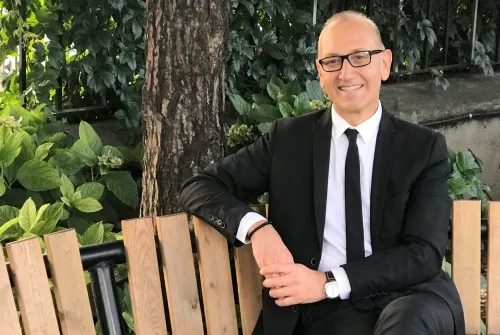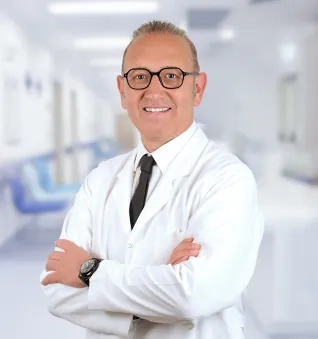Alo Yeditepe
Alo Yeditepe
The Things You Should Know About Prostate Cancer
Yeditepe University Kozyatağı Hospital Chief Physician and Urology Specialist Prof. Dr. Faruk Yencilek explained what needs to be known about prostate and prostate cancer, as well as the developments in the treatment process.
Professor, What Was the Reason That Caused You to Study Medicine?
As is typical for the province of Adana, my family was farming for a living. One day I read an article praising Prof. Dr. Gazi Yaşargil in the newspaper I found while working in the field during my secondary school years. That article affected me so much, and the ardor for studying medicine entered my heart that day. How lucky of me that it has been one of the most honorable coincidences that life has given me to have the opportunity to work together in the same hospital with my esteemed teacher Gazi Yaşargil, who had put this ardor in my heart, and to become his urology physician after many years.
How Did Your Paths Cross With Yeditepe University?
After graduating from Marmara University Faculty of Medicine in 1996, I qualified to attend İstanbul University Cerrahpaşa Faculty of Medicine in the same year, which was my first choice in the examination for specialty in medicine. Urology was a branch that I really wanted. After graduating from Cerrahpaşa Faculty of Medicine Department of Urology in 2001, for my academic career, I wanted to work at a university that had a vision. Meanwhile, the foundations of Yeditepe University Hospital had just been laid. In the meeting I had with Mr. Bedrettin Dalan during that period, he drew such a beautiful vision that I said, "I should work at a university like this." During that period, I was also about to start another public university. But I was so impressed by the vision drawn by Mr. Bedrettin Dalan that I really believed that I could do this job in Yeditepe and show my talent here. That's why I joined the staff before the hospital opened, and I've been here for 17 years.
Let's Talk About Your Specialty. Could You Inform Us A Little About the Prostate, The "Troublemaker" of Men?
Men who hear the word prostate always associate it with bad things. The prostate is perceived to be equal to a disease. However, the prostate is an organ that exists in every man and is vital for reproduction. Because the fluid produced by the prostate provides the proper nutrients and environment for sperm to live, and this organ begins to gain its function fully with puberty. With the increase of testosterone in puberty, the prostate takes that testosterone, turns it into another much more potent male hormone, and uses it to fulfill its functions fully. Thus, the prostate also produces the nutrient necessary for sperm and the substance that will keep that nutrient in a liquid state. When exposed to hormones to such an intense degree, several changes begin to occur in the organ (prostate) over time. However, hormonal factors alone will not suffice to initiate these changes. Studies show that genetic, hormonal, and environmental factors, advanced age, ethnicity, and eating habits play an important role in both benign prostate growth and prostate cancer development. In general, men begin to meet prostate enlargement after their 40s. Findings related to prostate enlargement begin to appear over the age of 40. Under the age of 40, on the other hand, urination-related difficulties can mostly be caused by a prostate infection or strictures of the urinary tract.
Is It Possible to Prevent Prostate Enlargement? What Measures Can Be Taken in This Regard?
It cannot be fully stopped. Because there is no single factor in the growth of the prostate. It is impossible to control and change all genetic, hormonal, and environmental factors. You cannot know and control them all, so you cannot change them either. But of course, in the name of taking precautions, some points can be taken care of. For example, the prostate does not like a high-calorie nutritional pattern. High-calorie foods are not suitable for both benign growth and prostate cancer. In addition, infections that develop due to unprotected sexual intercourse, especially in those having multiple sexual partners at a young age, can lead to the occurrence of prostate signs at an early stage, as well as scientific data are showing that it is associated with the future development of prostate cancer. For this reason, especially those with multiple partners should pay attention to protection. Apart from this, red meat is not good for the prostate. It is also necessary to stay away from saturated or unsaturated fatty acids. However, regular sports and exercise, as well as a diet suitable for our overall health, are also suitable for prostate health. In summary, red meat, fatty foods, a high-calorie diet, and obesity constitute an inappropriate nutritional pattern for the prostate. But we should note that diet alone is not enough to control cancer. But it has the ability to affect the course of cancer that has started.
We have Been Hearing a Lot about Prostate Cancer in Recent Years. How Has This Formation Changed in Years?
Prostate cancer usually ranks second in men after lung cancer. The same ranking also applies to our country. About 650-700 thousand new prostate cancer diagnoses are made every year in the United States, which is the country with the highest prostate cancer occurrence rate in the world. In Europe, this figure is around 350 thousand. Unfortunately, it has also started to occur with increasing incidence in our country. The reason why we hear about prostate cancer more often is the rising awareness of people and the development of screening methods. In prostate cancer, the goal is again to be able to diagnose the disease before it has given any signs. In order to achieve this, we widely use two screening methods. The first is a blood analysis called PSA, and the other is a rectal examination. Using these two screening tests, we can detect a clinically significant tumor by 70-80 percent. Therefore, regular health checks are vital in this sense. More prostate cancers can be detected now thanks to both screenings and regular health checks. However, we can now detect prostate cancer at an earlier stage. While most prostate cancers in the 1980s could be detected as metastatic, that is, when they had spread to other organs, nowadays, although more men are diagnosed with prostate cancer, they are detected at an early stage
Has a Decrease been Achieved in the Loss of Life Rates Due to This?
Yes, a significant reduction has been achieved in life losses. Our goal is to detect prostate cancer when the tumor is still limited to the organ (before it has spread outside the prostate) Because when it is detected at this stage, it can be possible to terminate the disease altogether through current treatment methods. Prostate cancer is a type of cancer with an insidious progression. PSA and regular urological checkups have increased the detection rate of prostate cancer. In addition, it has reduced the loss of life due to the disease by about 60 percent worldwide. Today, patients should also know these. In other words, patients should not just say, "I have cancer; what will I do?" Instead, their consciousness should come to such a level that the patient should ask their physician, "Is my cancer limited to the organ (Is it inside the prostate?), or is it outside the organ?"
Are There Any New Technological Developments in the Combat Against Prostate Cancer Today
There have been innovations at every stage of prostate-related disease. Because prostate cancer is one of the cancers for which the most research is conducted worldwide. Surgical techniques have also changed in recent years. The recipe for success in the treatment of prostate cancer detected at an early stage is not limited only to oncological results. We are looking at three critical outcomes called "trifecta." The first one is oncologically bringing the disease under control; the second is that the patient can maintain their erection after treatment; and the third is that he can continue his life without urinary incontinence. Significant success has been achieved in this regard. When we detect prostate cancer inside the prostate (limited to the organ), we divide it into three subgroups, “low-, medium-, and high-risk,” according to its potential to spread outside the organ. This distinction also determines our treatment approach.
Today, with the introduction of the "Multi-parametric Prostate MRI" diagnostic method, the rate of unnecessary prostate biopsy has decreased, while the accuracy rate of biopsy has increased. Thus, this technique can help us detect cancer at an early stage. According to the result of the multi-parametric Prostate MRI, it is possible to diagnose cancer only by taking a biopsy from the target. If the cancer is limited to the organ and is in the low or medium-risk group, it may also be possible to apply focal therapy as a treatment method. Namely, only the cancerous area is burned with special energy without the removal of the patient's prostate. In other words, we can cure the “local disease through focal treatment.” In the focal treatment, which has been widely used in recent years, only the cancerous tissue is burned, and the prostate does not end up being damaged. Thus, possible complications are prevented, and rapid recovery of the patient can be ensured. But in patients who are in the high-risk group, surgical treatment takes priority.
What Do You Recommend For Protection?
Prostate cancer has multiple causes. Genetic predisposition, advanced age, and ethnicity are the most important determinants. These are not controllable factors today. However, it is necessary to follow some essential rules related to nutrition and lifestyle changes that can help both prostate cancer prevention and cancer treatment. A monogamous life or protected sexual intercourse against sexually transmitted diseases and things to be done for general health, such as regular sports and healthy nutrition, are important also for prostate health. The linoleic acid found in red meat increases the rate of spread of prostate cancer that has started. For this reason, attention should be paid to the consumption of red meat. The second important point is excessive weight. A protein called leptin and an insulin-like growth factor found in adipose tissue contributes to the development and progression of prostate cancer. For this reason, precautions must be taken against excessive weight. In addition, it is necessary to stay away from fat-rich and high-calorie foods. On the other hand, tomatoes, green tea, and soy groups are foods that reduce the growth of prostate cancer cells due to the lycopene in them. It is essential to include these more in our diet.
About
Faculty and Year of Graduation:
Marmara University Faculty of Medicine, 1996
”
See Also
- ThuFLEP Treatment Improves Quality of Life in Benign Prostatic Hyperplasia
- Treatment of Urinary System Stones with Thulium Fiber Laser
- ThuFLEP Method in Benign Prostate Enlargement
- What is Prostate Cancer? Symptoms and Treatment
- What is Benign Prostatic Hyperplasia, How is it Treated?
- Early Diagnosis Saves Lives in Insidiously Progressing Kidney Tumors
- The Rate Of Kidney Stones Has Begun To Increase In Women
- HoLEP Eliminates 85 percent of Drug Use in the Treatment of Benign Prostate Enlargement
- Chronic Pelvic Pain
- Does Prostate Enlargement Develop into Cancer?
- One in Every Four Men Diagnosed with Cancer Has Prostate Cancer
- Ways to Protect Prostate Health
- Surgical Treatment of Prostate Diseases
- Ways to Get Rid of Kidney Stones
- Prostate Preventive Cancer Treatment: Focal HIFU
- HIFU Focal Treatment for Prostate Cancer
- HoLEP Method in Closed Prostate Surgery
- Benign Prostate Enlargement
- Who Can Undergo HoLEP Procedure?
- Gold Standard Treatment for Benign Prostate Enlargement: HoLEP
- 6 Misconceptions About Kidney Stones
- Her Kidney Stone, 6 cm in Size, Was Taken With One And a Half Hour Operation
Alo Yeditepe




